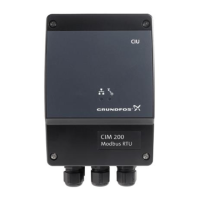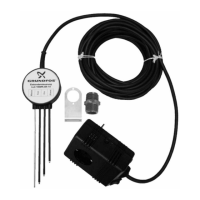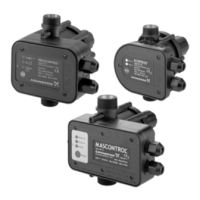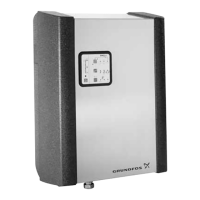7
PFU 2000 Startup
1. Have a qualified person
check for proper power
supply and plumbing
connections. Make sure
the main power is off.
2. Check that the air pres-
sure in the diaphragm
tank is 0.7 times the required discharge pressure
set-point (0.9 times for MS and MSH systems). System
pressure must not be applied to the tank connection
during the tank pre-charge process. If water is supplied
to the tank from the system, close the tank valve dur-
ing the pressurizing process.
3. Prime the system as follows.
Suction Pressure System (pumps are flooded at least as
high as the highest part of the pumps)
a. Close all discharge manifold pump isolation valves
and open all inlet manifold pump isolation valves.
b. Open the vent plug on top of each pump. It is a small
hex head screw in a large vent plug. Air and water
will escape from the pump through a small hole in
the large vent plug. When the air is out and water is
flowing steadily, tighten the small hex head screw
on the vent plug to stop the flow.
Suction Lift System (the water source is below the
pumps or does not flood the pumps to the highest point
on the pumps)
a. Close all discharge manifold pump isolation valves
and open all inlet manifold pump isolation valves.
b. For suction lift applications, a foot valve must be
placed on the inlet piping at the water source (tank,
etc.). If there is a fill point above the highest point of
the pumps, you may fill the system from this point.
If there is no fill point above the highest point of the
pumps, remove the large vent plug on each pump.
Fill each pump until the water is up to the vent plug,
then replace the vent plugs.
4. Check the inlet manifold pressure gauge. The inlet
pressure must be at least 5% of the maximum pressure
transducer rating (if a transducer is used). If another
type of dry run protection is used, ensure that sufficient
suction pressure is available for safe operation of the
pumps.
5. Ensure all circuit breakers are in the “on” position. The
control panel door must be open at this time.
6. If an isolation valve has been installed on the discharge
manifold, close it. If not installed, make sure the dis-
charge pump isolation valves are closed. Switch on
main power (the pumps may start at this time).
7. Turn the Function
Selector (small knob
on the PFU Controller)
on the PFU 2000 to
“Max” (see drawing
at right) (full clock-
wise rotation).
If the pumps did not
start in Step 6, they
will start after approx-
imately 15 seconds.
8. Vent the system by opening the vent plug on each
pump (as in Step 3). Venting with the pumps running
ensures all air is removed from the suction. Do not run
the system with the discharge manifold pump isolation
valves closed for more than five minutes to prevent
overheating of the pump liquid.
9. Once the pumps have been fully vented, turn the PFU
2000 Function Selector to “Stop” (full counter-clock-
wise). As the pumps stop, check the pump rotation. If
the area is dark, a flashlight may be required, or remove
a coupling guard on each pump for better visibil-
ity. Disconnect main power when removing coupling
guards. Do not touch the couplings while the pumps
are turning as injury may result. Replace all coupling
guards after the rotation check. Disconnect main power
when removing and replacing coupling guards (or open
service disconnect switches if this option was supplied).
If the rotation is incorrect on any 3 phase pumps, switch
any 2 of the 3 power main wires supplied to the control
panel (L1, L2, L3).
10. Open the discharge manifold isolation valve and the
isolation valves for each pump. Turn the PFU 2000
Function Selector clockwise approximately 50% of full
rotation, allow the system to come up to speed, then
slowly adjust the Function Selector until the system
maintains the desired set-point pressure as read on the
discharge pressure gauge.
NOTE: If you are filling an empty piping system, do not
allow the pumps to run with the valves wide open as
cavitation may occur.
NOTE: If the set-point is changed, readjust the dia-
phragm tank precharge pressure to 0.7 times the new
fluid pressure setting (0.9 times for MS and MSH sys-
tems). Check the diaphragm tank air pressure while no
fluid pressure is applied to the tank (see Step 4).
Your BoosterpaQ is now ready for operation.
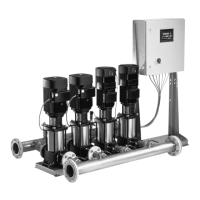
